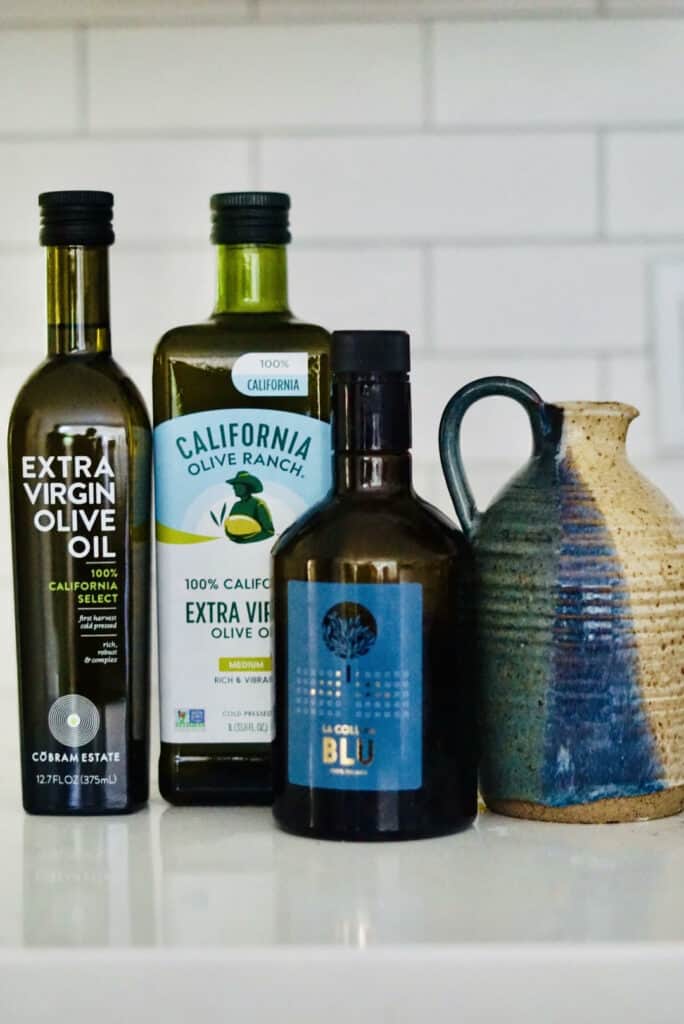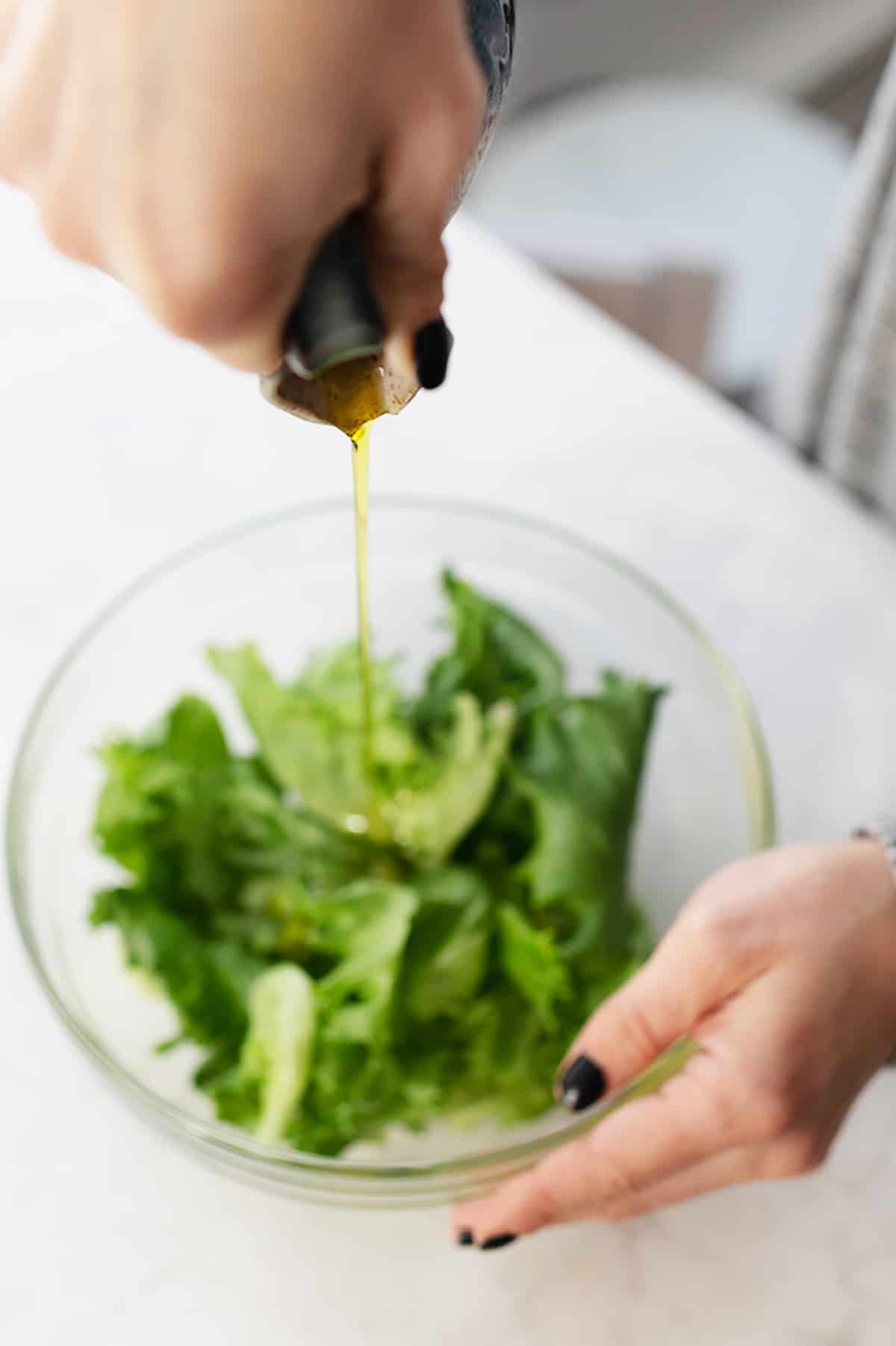If you are like me and use olive oil almost every day, it is important to understand how important the quality of olive oil is! Today I am delving into everything you need to know about olive oil!
If you spend a lot of time cooking, you may use quite a bit of olive oil.
Olive oil is the staple food in many savory recipes…even some sweets! But many of us-myself included-don’t actually know that much. If you know me, you will know that whenever I often put something into my body (not to mention giving it to my loved one), I want to know as much as possible. I think it’s time for a deep dive in olive oil!
Let’s start with the basics.
How is olive oil made?
This is very obvious, but we are delving into it here, so please be patient: olive oil comes from olives.
Olive oil production has a long history in the Mediterranean. For decades, generations of olive growers have passed down their secrets. Before turning them into olive oil, the olives must be cared for so that they can mature for several years. Caring for olives is a delicate process that requires extensive pruning.The production of olive oil is a quality issue with Quantity-At least ten pounds of olives are required to produce one liter of olive oil.
The olives are picked—sometimes by hand—and then transported to the processing plant. Usually, the olives are processed quickly after harvest to avoid any damage to the olives and maintain their quality. The leaves, branches and stems are removed, then the olives are washed, then crushed and ground into a paste with a stainless steel roller.
Next is stirring, which is a process of slowly stirring the water into the olive paste. The mixture is then stirred for another 20 to 40 minutes-enough time to make the oil more flavorful, but not long enough to expose it to free radicals in the air that affect its quality. Some factories use closed mixing chambers to prevent this oxidation during the mixing process.
The olive paste is placed on a mat, further pressed, and then filtered through a centrifuge to remove any solid residues in the olive paste. The water and oil are extracted from the centrifuge and separated later. The oil is then refined, bleached, and/or deodorized according to the manufacturer’s traditions, preferences, and recipes. Then store it in a 65*F stainless steel container until bottling and shipping.
From there, it will find a store near you and then arrive at your kitchen!
As you may already know, there is more than one type of olive oil. We will talk about it next.
Types of olive oil
Now that we understand the basics of olive oil production, let us consider the available olive oil varieties. Everyone’s production process is different.
- Extra virgin olive oil. When it comes to olive oil, this is the best! If you plan to put a bottle of olive oil in the kitchen, EVOO may be your best choice. Extra virgin olive oil is made from olives with the least rot because they are crushed shortly after harvest. It’s hard to argue with it! EVOO must also pass the taste test of the judging panel before selling to ensure that it has the best flavor.
- Extra virgin olive oil. One level lower than EVOO, you have virgin olive oil. Olives in virgin olive oil usually sit longer between harvest and pressing, so they have a higher acidity. It is suitable for frying, roasting, baking, frying, and sauces, but it is not recommended for seasoning or finishing dishes because it is not as flavorful as EVOO.
- olive oil. You may have found a pattern here, right? If you guess that the standard olive oil is one step lower in quality than virgin olive oil, then you are right. It has been bleached, neutralized and deodorized during the refining process. It should really only be used during frying, roasting and medium-temperature frying, because the taste will not be affected.
- Light olive oil. This is a low-quality olive oil blended with other highly refined oils. It doesn’t have the health benefits of other EVOO or virgin olive oil, but like regular olive oil (pictured above!), you can use it for basic kitchen work if needed.
- Olive pomace oil. After olives are pressed, the remaining solid pulp is called pomace, which can then be turned into oil. Chemical solvents are used to produce it, so if you see “olive pomace oil” on the label, you should stay away from it.

Health benefits of olive oil
I mentioned above that EVOO and virgin olive oil are good for health. You may have heard of these benefits, especially those related to other oils and butters.
The following are some of the benefits of olive oil, according to Health hotline:
- It is rich in healthy monosaturated fats such as omega-3 and omega-6 fatty acids.
- Olive oil is rich in antioxidants, which can reduce the risk of chronic diseases.
- It can reduce inflammation throughout the body. Experts believe that chronic inflammation can lead to many diseases ranging from cancer and heart disease to type 2 diabetes and Alzheimer’s disease.
- It has been proven to help prevent stroke and prevent heart disease.
- Although it is a fat, olive oil has nothing to do with weight gain or obesity, which makes it an excellent substitute for butter and other oils.
- It has antibacterial properties and may help fight bacteria in the stomach.

But how do you choose correct Can olive oil be used in dishes for you and your family? If you include olive oil in your regimen because of its healthy properties (and of course its deliciousness), I’m sure you want to make sure that you choose high-quality products.
Here are some things to be aware of and avoid…
Next time you buy olive oil, please pay attention to these high-quality olive oil signs…
- As you have read above, extra virgin olive oil is usually the best olive oil on the olive oil shelf. If it is marked with EVOO, it is likely to be a high-quality product.
- The best olive oil producers in the game usually mark their oil with the harvest date. Please pay attention to the date before buying.
Here are a few things to be careful…
- Clear glass bottles are bad news, even if they have beautiful labels. The light is very harmful to olive oil, so if it is packed in a transparent bottle, it is likely to have been damaged.
- Don’t be fooled by the phrase “cold press first!”This is not necessarily a bad Thing, but it is also technically redundant, so please be aware of the fact that manufacturers may use it to oversell their products.
How to store olive oil correctly
After choosing the ideal bottle of olive oil, you must make sure to store it properly to keep it fresh.Unlike wine and cheese, olive oil does not always get better over time will If you don’t pay attention, the quality will decrease.
Put olive oil in a cool, dark environment to protect it from light and heat, both of which are its enemies. Use it then! Don’t let it sit too long, because the sooner you add it to the recipe, the fresher it will be.And because it has all these health benefits, you don’t need to emphasize adding it generously.
Notes on cooking with olive oil…
The smoke point of olive oil-which is just a peculiar term for the temperature at which cooking fat stops flickering and starts to smoke-has caused some controversy among gourmets and other experts. It is worth noting that fats with higher smoke points generally undergo industrial-grade refining processes such as bleaching, filtering, and high-temperature heating. Fats and oils with lower smoke points have less intervention.
In recent years, there has been concern that heating olive oil to its smoking point (between 325 and 375* F) may release harmful compounds into the food being prepared. Of course, this sounds dangerous!
according to U.S. News HealthIn fact, it is very rare that you completely reach its smoke point when using olive oil. They assure consumers that there is no reason to worry about this issue-but it is still something to be aware of.

Check out some of my favorite recipes featuring olive oil…
enjoy your meal!

